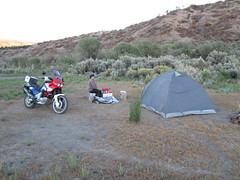Traveling in the USA:
Advice for Camping



My husband and I regularly meet people from other countries traveling in
the USA who want to camp most of the time, either in a tent or a caravan /
RV / travel trailer. We find ourselves giving them the same advice over
and over on where to find campgrounds in the USA - to the point that my
husband said to me, "Why don't you put this information on your web site?"
So, here it is.
This isn't advice on where to find RVs / caravans to rent. This is advice
on where to find campgrounds in the USA, whether you are tent camping, car
camping or have a caravan, and how to know the difference in these
campgrounds in terms of price and amenities.
And when I say travel season here, I mean Memorial Day weekend (ends with
last Monday in May) through Labor Day weekend (ends with first Monday in
September).
I divide campgrounds into the following categories:
- Privately-owned campgrounds (these are for-profit businesses)
- State park campgrounds (these are operated by the government of the
state you are in - Kentucky, Oregon, South Dakota, whatever)
- National Park & National Monument campgrounds (these are operated
by the US federal government)
- County campgrounds (these are operated by the county government of the
region of a state you are in)
- National Forest campgrounds
- Bureau of Land Management (BLM) official campgrounds
- BLM public lands
Here's how I define the difference in these camp grounds, from most
expensive to least:
Privately-owned campgrounds
Cost: $20 - $70 (or more) a night
Features usually include:
- Wireless Internet access (included in price)
- Drinking water
- Shared kitchens or at least a dish washing station
- Flush toilets
- Sinks with hot water
- Hot showers (included - usually no need for quarters or coins)
- Dump/disposal station
- Electricity at the camp site for travel trailers and RVs
- An office where there is always someone working during regular
business hours and where you can find brochures for area attractions
- Sometimes, there's a small store with some basic items, like aspirin,
ibuprofen, cough medicine, eggs, etc.
Private camp grounds may have cabins or yurts available for rent. These may
have just beds and some basic electricity - heat, but no bathrooms or
running water - or may be fully equipped with a bathroom, shower, kitchen
and cooking pans, TV, etc. If you have your dog or dogs with you, check to
see if the cabins or yurts are "pet friendly" - many aren't.
Many private campgrounds do NOT allow tents, or they may allow tents, but
not welcome such, packing tent campers together on a tiny plot of land.
Many private campgrounds will NOT permit you to camp in a car - they will
take people only in travel trailers or truck campers or who will pitch a
tent next to their car. This is because they don't want people who are
houseless staying at their sites.
State park campgrounds
Cost: $15 - $30 a night for
tent camping
Features usually include:
- Drinking water
- Flush toilets
- Sinks with hot water
- Hot showers (included - usually no need for quarters or coins)
- A picnic table for each site
- Dump/disposal station
- Free interpretive programs (could be a ranger giving a presentation
about local history, could be a modern
observatory with star-gazing programs)
- Onsite camp host (a volunteer)
- Fire pit
- Firewood for sale (but not always - best to buy such before you go to
the camp ground)
Some state parks have camp sites just for travel trailers and RVs that
have electricity at the camp site.
Some state parks have wi-fi.
Some state park camp grounds have cabins or yurts available for rent. These
are usually reserved weeks, even months, in advance. Most will not be
available on a weekend unless you reserve. These may have just beds and some
basic electricity - heat, but no bathrooms or running water. If you have
your dog or dogs with you, check to see if the cabins or yurts are "pet
friendly" - many aren't.
State parks will have paved roads and paved camp site driveways within the
park. However, some might have
dirt or gravel roads to get to the park - this is especially true of state
parks in the Western USA in remote areas. And remember: not every state park
has a camp ground! Don't assume one does unless you see a sign for such at
the park entrance!
After a few days in national park, national forest and BLM camp grounds, I
like camping in a state park campground, for the hot showers.
Many state parks are fully booked every night in-season. If you can, reserve
your site as far in advance as possible - you can do this via the web. If
they do have openings for a campsite on the night you arrive without a
reservation, you often will be allowed to camp only one night - you will
have to go find Internet access to book online to reserve to stay more than
one night. If the campground is at least half empty, you may get away with
just paying each night and not reserving, but if you chance it, someone
could show up the next day and say, "Hey, you have to move - this is my
campsite, I reserved it online."
County
campgrounds
Cost: $10 (rare) - $35
a night for tent camping
Some may have cabins and yurts available as well. Most places are geared
towards RV campers and large groups and families.
County campground are a rarity in the USA. In fact, I've seen them only in
Oregon. I don't mean county FAIR campgrounds - I mean actual county
campgrounds in a forest or near an ocean.
Features usually include:
- Drinking water
- Flush toilets
- Sinks with cold water (sometimes hot too)
- A picnic table for each site (or at least one for every two tent
sites)
- Dump/disposal station
- Interpretive programs (about local history, local geography, local
wildlife, local native cultures, star gazing, forest fires, and on and
on)
- Onsite camp host (a volunteer)
- Fire pit
- Firewood for sale (but not always - best to buy such before you go to
the camp ground)
Hot showers may be available as well.
County campgrounds vary hugely in terms of quality. Some have all the
campers packed tightly together and nothing scenic to see. Some are
incredibly beautiful and have great hiking all around. And while I said
that they usually have flush toilets, many do not. You just never know
until you get there!
National
Park & National Monument campgrounds
Cost: $15 (rare) - $30
a night for tent camping
Features usually include:
- Drinking water
- Flush toilets
- Sinks with cold water (sometimes hot too)
- A picnic table for each site (or at least one for every two tent
sites)
- Dump/disposal station
- Interpretive programs (about local history, local geography, local
wildlife, local native cultures, star gazing, forest fires, and on and
on)
- Onsite camp host (a volunteer)
- Fire pit
- Firewood for sale (but not always - best to buy such before you go to
the camp ground)
Hot showers may be available at the main offices, but these can be a mile
from your camp site. There is often a charge for hot showers.
All roads and driveways within the park will be paved.
For extremely popular National Parks, like Yellowstone, Glacier, Yosemite,
Arches, Mammoth Cave, Crater Lake, etc., you
will need to make reservations in advance, even for a tent site, at
least for the weekends and usually any week night within travel season (late
May to early September). Reservations for these sites are NOT handled by the
parks themselves but, rather, a private company. For all REALLY popular
national parks, there are private campgrounds outside the park, quite near
the entrance - and often, they are LESS expensive than staying in the park.
National Forest and National Refuge campgrounds (and state forest
campgrounds as well)
Cost: $5 - $15 a night
Features usually include:
- Drinking water (faucet or pump - but not always; the info board at the
entrance will tell you)
- Vault/pit toilets
- A picnic table for each site
- Garbage cans (but not always - you may have to pack everything out)
- Fire pit
- Onsite camp host - a volunteer (but not always)
- Firewood for sale (but not always - best to buy such before you go
into the camp ground)
Many, but not all, National Forest campgrounds will have paved roads and
paved camp site driveways within the park, and small caravans / travel
trailers are welcomed - but larger vehicles may be prohibited (length
restrictions will be posted at the entrance). National Refuge campgrounds
may have NO pavement at all in camp grounds. The information board at the
refuge main office will tell you.
You can find these via the recreation.gov
web site, or type in the name of the state you want to visit and the phrase
BLM campgrounds into google.com or bing.com.
More advice about finding these camp sites is at the end of this article.
And I have to say: these are my very favorite campgrounds.
BLM developed campgrounds
Cost: $varies
Features:
- May or may not have drinking water (the info board at the entrance
will tell you)
- Vault/pit toilets
- May or may not have a picnic table for each site
- May or may not have garbage cans (that means you have to take your
trash out of the camp site and find a place to throw it away
appropriately)
- Onsite camp host - a volunteer (but not always)
- Fire pit
- Firewood for sale (but not always - best to buy such before you go to
the camp ground)
BLM campgrounds can be found in all Western states. Here are some of my
favorite sites to look for such online:
You can find more via the recreation.gov
web site, or type in the name of the state you want to visit and the
phrase BLM campgrounds into google.com
or bing.com. More advice about finding
these camp sites is at the end of this article.
BLM public lands - undeveloped/primitive
sites
Cost: $0
The public lands of the USA are open to camping. There is no fee for
dispersed, primitive camping, but there is a limit to the number of days one
may camp in the same location. Dispersed, primitive camping is camping
where there are no developed amenities such as water or toilets. Primitive
campers are asked to follow the "Leave No Trace" land use ethics.
Dispersed camping in a motorhome is allowed, but dumping black or gray water
on the public lands isn't allowed.
These aren't official camp grounds. There's no official camp sites, no
vault/pit toilets, picnic tables, etc. It's just an open field. But often,
you can find a fire pit that someone else has dug out. If you find a fire
pit with firewood and kindling in it, ready to burn, and you decide to use
it, then camping etiquette is that you leave it the next day with firewood
and kindling in it, ready to burn for the next camper.
These are NOT good places for travel trailers or caravans, except for small
ones. The roads are dirt or gravel, there can be massive ruts in the road,
and there is NO ONE around to help you if you get stuck.
 How
to find BLM land? It's best to have a state map that shows where there is
BLM land. You can find such online as well. Become familiar with the
BLM logo - it's usually on a brown wooden sign, with white lettering,
on a small sign along the road - the logo may be very very small. At left
you can see the kind of sign that indicates public lands.
How
to find BLM land? It's best to have a state map that shows where there is
BLM land. You can find such online as well. Become familiar with the
BLM logo - it's usually on a brown wooden sign, with white lettering,
on a small sign along the road - the logo may be very very small. At left
you can see the kind of sign that indicates public lands.
You won't find these along US freeways - you will find them via remote,
two-lane US highways and state roads.
Here's a great list of BLM
camp grounds in Nevada that includes some undeveloped sites, but
there's no way to list all the undeveloped sites in all states - there are
so many! For instance, the camp site we had, at left, isn't on this list.
You can find some official sites via the recreation.gov
web site, or type in the name of the state you want to visit and the phrase
BLM campgrounds into google.com or bing.com.
More advice about finding these camp sites is at the end of this article.
Guard stations, ranger cabins, fire
lookouts
Cost: Varies
The national park service rents these out! They can sleep from 4 to 12
people. There will be running water and beds, but that's it; there may not
even be electricity, and bathrooms will be pit toilets. These will often be
at the end of dirt roads and, often, large RVs won't be allowed because of
the road conditions leading to the structure (switchbacks, severe climbs,
dirt and gravel, etc.). You can find these, and reserve such, via the recreation.gov
web site. Reservations are a must, and you will have to stop by the nearest
ranger station to pick up (and drop off) keys and such.
Do I really have to pay?
At many national forest and BLM camp grounds, there's no office and no camp
host. You pay by going to the information board near the entrance and follow
directions to pay. That usually involves filling out a form on an envelope
that is provided at the info board, with your name, your license plate
number, etc. You put your payment, by check (which, as a foreigner, you
probably don't have), by cash, or by a credit card number. The form you fill
out usually separates from the envelope - you put the envelope in a strong
box or large, metal tube with a small slit in it and a lock on it that staff
will open later, and you put the part of the form that ripped off onto the
sign at your campsite with the campsite number on it. We like to pick our
camp site first and then walk back to the information board to pay.
Yes, you really do have to pay!! You might get away with not paying - maybe
a ranger, park staff or sheriff won't come into the camp ground while you
are there. But, geesh, camping in such areas is SO CHEAP. That money is
hugely important to pay for that camp ground. In fact, even all of the
camping fees are NOT enough to maintain the grounds - government (all tax
payers) have to supplement the costs. Please pay. If people don't pay, these
campgrounds are going to go away.
Volunteer camp hosts?
What are these onsite volunteer camp hosts I mention above? These are people
that agree to live in a camp ground for at least a season, sometimes even
longer. They are responsible for making sure the campsite and campers are
safe and happy. They usually don't do things like clean the bathrooms or
take camping fees - bathrooms are cleaned by paid employees in the mornings
and fees are taken in a strong box near the park's entrance by park
employees. Camp hosts often sell firewood. Sometimes, completely
unofficially, they might sell you beer. The camp host can tell you where the
nearest store is for gas, food, beer, etc. He or she can also tell you where
the nearest hospital is. The camp host is who you go to if other campers are
being loud, if you find food in your fire pit left by previous campers and
need it removed, if you see a bear or cougar, etc. But if you see a crime
being committed, have been the victim of a crime, or are feeling unsafe or
threatened while camping, call 911 and talk directly to local law
enforcement (after the call, tell the camp host as well).
Which do we prefer?
My favorite campgrounds are National Forest and state forest campgrounds.
They are usually somewhere really beautiful and isolated, and if there is a
camp host, that person is the nicest, most helpful person EVER. Also, each
individual camp site is generous - you get a lot of space for the small
amount of money. While pit toilets aren't my favorite, the ones here in the
USA are always clean, and there are plenty. And the people that stay in
these camp grounds are usually focused on sleep at night, not staying up and
partying.
My least favorite campgrounds are KOA (Kampgrounds of America) and similar
private, for-profit camp grounds. I find that they are not welcoming of
tents, pack everyone extremely close together, and don't have enough
showers. They aren't horrible - we'll camp there if that is absolutely all
that is available - but we'll drive another hour if it means finding
something else.
National park campgrounds in really popular national parks, like
Yellowstone, are my second least favorite. There is just so much stress to
get a spot, and you may be a mile from the shower in relation to your camp
site. That said, I still love them more than hotels: I love the evening
ranger programs, and I love meeting other people at the camp site, because
they are usually very interesting.
Where do you find these campgrounds?
Many of these campgrounds are NOT on paper maps of states. Even if a
state park is on your map, it may not have a camp ground, or if it does,
it may not be noted on the map. Happily, the international symbol for
campgrounds is being used more and more in the USA on highway exit signs.
If you see a sign that is brown, with white lettering, that means a
national, state or even county site.
Apps are great - but note that, for the best places, you aren't going to
have phone nor Internet access to find these great campgrounds.
We love stopping at ranger stations to ask about area camp grounds. Even if
the station is closed, they often have camping information posted on an
information board outside the office.
You usually won't find signs for campgrounds along US freeways (large,
four-lane roads) - instead, you will find them via remote, two-lane US
highways and state roads. Just like in Europe, most camping signs are a
white logo on a brown background, but sometimes, the background is blue
instead.
BLM public land isn't the easiest to find on your own. It's best to get a
map that shows where BLM land is, and when you are in the town nearest that
land, ask someone if they can recommend public land to camp on. We find it's
best to ask at small grocery stores, government offices (we are forever
indebted to the planning office in Austin, Nevada for telling us about an
absolutely magical place to camp on BLM land), or hardware stores, rather
than gas stations. Ranger stations are the best place to ask. We
have also dared to just go out and try to find such on our own. Be sure you
attempt this with lots of daylight still left.
BLM land is often surrounded by fences. If you think land is public land,
and you want to camp there, and you see a fence and gate, drive up to the
fence and look for a sign; if it says private property, don't camp there.
But the sign may say, "Please close any gates" or "Please leave gates as you
found them." What that means is that these public lands are rented by local
ranchers to graze cattle. DO NOT CAMP NEAR CATTLE. If there are cows, sheep
or other animals nearby, don't camp there.
Also see:
Cottonwood Canyon State Park in Oregon,
September 2018. Near Wasco and Moro, Oregon. Not far from the Columbia
River Gorge. A long weekend car camping trip with our dog that started
in Washington State.
Review of Camp Wilkerson, Columbia
County, Oregon, from June 2018. Great place to camp and hike
over a couple of days. West of Portland, not far from PDX, yet you
will feel like you are a million miles away from the city. This was a
weekend car camping and hiking trip with our dog.
Review of Trask River County
Campground, Tillamook County, Oregon, in March 2022. This was a
weekend car camping and hiking trip with our dog, and the maiden
voyage of the custom square drop camper built
by coyotetrips.
My favorite North American Ghost towns /
historic mining towns / pre-1900s towns
Advice for Traveling Around
the USA Camping & Hiking
Women's Safety While Tent Camping
Camp however YOU want to!
Disclaimer
Any activity incurs risk. The author assumes no responsibility for the
use of information contained within this document.
_______________________________________________






Disclaimer: Any activity incurs risk. The
author assumes no responsibility for the use of information
contained within this document.
This material is provided as is, with no expressed or
implied warranty.
Permission is granted to copy, present and/or distribute a
limited amount of material from my web site without
charge if the information is kept intact and is
credited to Jayne
Cravens
Please contact me for
permission to reprint, present or distribute these materials
(for instance, in a class or book or online event for which
you intend to charge).
The art work and material on this site was created
and is copyrighted 1996-2025
by Jayne Cravens, all rights reserved
(unless noted otherwise, or the art comes from a link to
another web site).
The personal opinions expressed on this page are solely
those of Ms. Cravens, unless otherwise noted.






 How
to find BLM land? It's best to have a state map that shows where there is
BLM land. You can find such online as well. Become familiar with the
BLM logo - it's usually on a brown wooden sign, with white lettering,
on a small sign along the road - the logo may be very very small. At left
you can see the kind of sign that indicates public lands.
How
to find BLM land? It's best to have a state map that shows where there is
BLM land. You can find such online as well. Become familiar with the
BLM logo - it's usually on a brown wooden sign, with white lettering,
on a small sign along the road - the logo may be very very small. At left
you can see the kind of sign that indicates public lands.